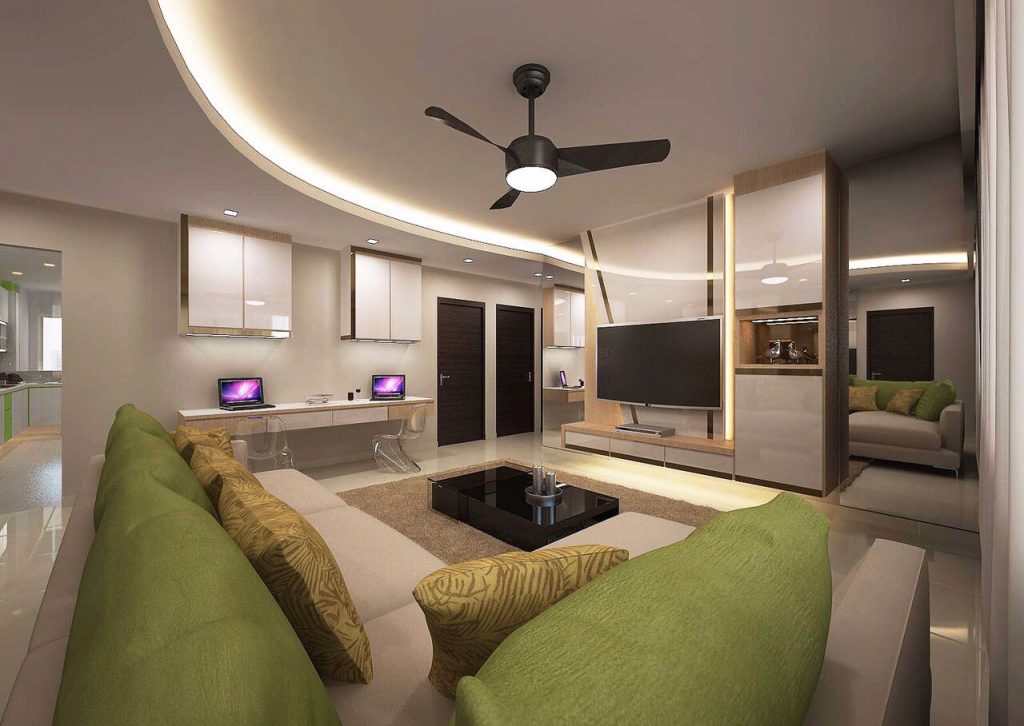
Sustainable Renovation in Singapore: Reducing Your Carbon Footprint
Renovating your home can be an exciting opportunity to create a space that better reflects your style and needs. However, it’s important to approach renovation projects with sustainability in mind. As we become increasingly aware of the impact our actions have on the environment, it’s crucial to consider the carbon footprint of our homes and take steps to reduce it. By making conscious choices about materials, systems, and design, you can create a space that not only looks great, but also minimizes its environmental impact.
In this article, we’ll explore sustainable renovation options in Singapore and provide tips and strategies for reducing your home’s carbon footprint.

Evaluating Your Current Home
To evaluate your home’s current energy efficiency and environmental impact, consider the following tips:
- Conduct a home energy audit to identify areas where energy efficiency can be improved, such as air leaks or insufficient insulation.
- Assess your current lighting setup and consider switching to LED bulbs, which use less energy and last longer than traditional bulbs.
- Look for appliances that have an Energy Star label, which indicates that they meet energy efficiency guidelines set by the U.S. Environmental Protection Agency.
- Evaluate your heating and cooling system, and consider upgrading to a more efficient model if your current system is outdated or inefficient.
- Check your windows and doors for drafts or leaks, and consider adding weatherstripping or caulking to improve insulation.
- Assess your water usage and look for ways to conserve water, such as installing low-flow showerheads or fixing leaky faucets.
- Evaluate your transportation habits and look for ways to reduce your carbon footprint, such as carpooling or using public transportation.

Sustainable Materials and Design
When it comes to renovating a space with sustainability in mind, there are several principles to consider. These principles should guide the selection of materials and the design of the space, in order to minimize environmental impact and ensure long-term sustainability.
Sustainable materials should be prioritized in renovation projects. Here are some examples of eco-friendly materials to consider:
- Bamboo: A fast-growing, renewable resource that can be used for flooring, furniture, and even as a substitute for traditional wood.
- Recycled glass: Made from post-consumer waste, recycled glass can be used as a material for countertops, backsplashes, and tiles.
- Salvaged wood: Reclaimed wood from old buildings, boats, or other structures can be used for flooring, paneling, and furniture.
Designing a space to maximize natural light and ventilation is also an important aspect of sustainable renovation. Here are some strategies to consider:
- Installing large windows or skylights to allow more natural light into the space
- Using light-colored paints or finishes to reflect more light around the room
- Choosing high-performance windows and insulation to reduce energy loss
- Incorporating operable windows or vents to allow for natural ventilation
- Incorporating outdoor living spaces, such as patios or porches, to increase access to fresh air and natural light

Energy-Efficient Systems
When it comes to reducing your home’s energy consumption and carbon footprint, there are several energy-efficient systems to consider. These systems can help you save money on energy bills while also reducing your impact on the environment.
Here are some examples of energy-efficient systems that you can consider:
- Solar panels: These panels generate electricity by converting sunlight into energy. This renewable energy source can reduce your reliance on traditional fossil fuels and lower your energy bills over time.
- Smart home technology: Smart thermostats, lighting systems, and appliances can be programmed to operate at optimal times and energy levels, reducing your overall energy consumption. These systems can also be remotely controlled, allowing you to adjust your energy usage when you’re away from home.
- Energy-efficient HVAC systems: High-efficiency heating and cooling systems can help you save energy and reduce your carbon footprint. These systems are designed to use less energy while still providing the same level of comfort.
- Energy-efficient lighting: LED bulbs are much more energy-efficient than traditional incandescent bulbs. They use up to 75% less energy and can last up to 25 times longer.
Water Conservation
Water conservation is an important aspect to consider when renovating your home. Conserving water can help reduce your water bills, but more importantly, it can help protect this valuable natural resource. Here are some tips and examples of water-saving fixtures and appliances to consider during your home renovation:
Tips for conserving water in your home renovation:
- Fix any leaks: Leaks waste a surprising amount of water, so it’s important to fix them as soon as possible.
- Install low-flow fixtures: Low-flow showerheads, faucets, and toilets use significantly less water than traditional fixtures, while still providing the same level of functionality.
- Choose water-efficient appliances: Look for appliances with a high Energy Star rating, which means they are designed to use less water and energy.
Examples of water-saving fixtures and appliances:
- Low-flow showerheads: These showerheads can reduce water usage by up to 50%, without sacrificing water pressure or shower quality.
- Dual-flush toilets: These toilets have two flushing options: a full flush for solid waste and a half flush for liquid waste. This allows you to conserve water while still ensuring effective waste removal.
- Water-efficient washing machines: High-efficiency washing machines use less water and energy than traditional models, and can also be gentler on your clothes.
- Faucet aerators: These devices can reduce the flow of water from your faucet by up to 50%, without reducing water pressure.
Implementing these water-saving tips and installing water-efficient fixtures and appliances can have a significant impact on reducing your water usage during your home renovation.
Waste Reduction and Recycling
Reducing waste during a renovation project is important for both environmental and cost reasons. Here are some strategies for reducing waste during a renovation project:
- Plan carefully: Before starting your renovation project, carefully plan the materials you will need and the amount required. This can help prevent overbuying and reduce waste.
- Salvage and reuse: Whenever possible, consider salvaging and reusing materials from your renovation project. This can include old fixtures, cabinetry, and even flooring materials.
- Recycle: Recycling materials such as metal, glass, and plastic can help reduce the amount of waste that goes into landfills. Look for local recycling programs or companies that offer recycling services.
In Singapore, there are several recycling programs and resources available to help reduce waste during renovation projects. Here are some examples:
- National Environment Agency (NEA): The NEA offers a comprehensive list of recyclable materials, as well as recycling programs and initiatives in Singapore.
- Public Waste Collection (PWC) services: PWC services include the collection of recyclable materials, as well as bulky items such as furniture and appliances.
- E-waste recycling program: The Singapore government has implemented an e-waste recycling program, which aims to reduce the amount of electronic waste that goes to landfills.

In conclusion
Sustainable renovation is more than just a trend – it’s a crucial step towards creating a healthier and more environmentally-friendly future. By prioritizing sustainability in your home renovation project, you’re not only doing your part to reduce your carbon footprint, but you’re also creating a space that is healthier for you and your family.
With the tips and strategies we’ve provided, you can make informed choices about materials, systems, and design that will help you achieve a more sustainable home. So take the first step today and start making conscious choices to reduce your impact on the environment. Together, we can create a better future for ourselves and for the planet.
Renovate your house with Interior Times!
Interior Times is the answer for you, If you are looking for a luxury place to live, then the home you choose should be the best in every way. Your home should look good, but it also should feel good. It is best for the experienced and professional team from Interior Times to avoid any unwanted results and problems in the end due to inexperienced interior design firms. Here are the things that you can get with our service:
- A leader in the luxury housing sector for commercial and private use
- Different renovation packages for all our clients
- Increasing the value of your property and ensure its future-proofed for future buyers
No need to hassle in renovating your dream house. Contact us here to get more information or visit our showroom at 3 Ang Mo Kio Street 62 #01-08 Link @ AMK , Singapore 569139.
Frequently asked Question
1) What is sustainable renovation?
A: Sustainable renovation is the practice of making eco-friendly choices when renovating a home in order to minimize the environmental impact of the project. This can include using sustainable materials, energy-efficient systems, and water-saving fixtures.
2) Why is sustainable renovation important?
A: Renovation projects can have a significant impact on the environment, from the materials used to the energy consumed during construction and beyond. By prioritizing sustainability in renovation projects, we can reduce our carbon footprint and create healthier, more eco-friendly living spaces.
3) What are some examples of sustainable materials for renovation projects?
A: There are many sustainable materials that can be used in renovation projects, such as bamboo, cork, reclaimed wood, and recycled glass. These materials are renewable and often require less energy to produce than traditional building materials.
4) How can I reduce energy consumption during a renovation project?
A: There are many ways to reduce energy consumption during a renovation project, such as using energy-efficient lighting, installing insulation, and choosing energy-efficient appliances. You can also consider using renewable energy sources, such as solar panels, to power your home.
5) Are there any incentives for sustainable renovation in Singapore?
A: Yes, there are several incentives and programs in Singapore that encourage sustainable renovation, such as the Green Mark Scheme and the ECO Fund. These programs provide financial incentives for eco-friendly renovation projects and can help offset the costs of sustainable materials and systems.
